VARCO Remodel and Replace Resource Center
I got 3 estimates from 3 window companies for my 3-flat. Two gave me low prices, and then came the hidden charges. Varco Windows delivered what was quoted with no extra or hidden charges. I got quality windows, installation and service at the price I expected. In the future, I'll call Varco.
– Tom, Chicago, IL![]()
Welcome to the VARCO Remodel and Replace Resource Center. On this page, you will find links to information that will help guide you through your window and door replacement project. For your convenience, we've also provided links to resources for other types of remodeling and home improvement projects.
Please download our buying guide which illustrates all of the ins and outs of replacement window and door products.
Remodel and Replace Resource Center Topics
The following topics will be discussed:
- Replacement Windows
- Design Ideas with Vinyl Replacement Windows
- Cleaning and Care Tips for Vinyl Replacement Windows
- Understanding Condensation
- Window Safety
- High Rise Fire Safety
Topic: Replacement Window Tips — Top Features to Look for When Replacing Windows in Your Home
With today’s high-performance window technology, you can have a proven solution to resist the sun’s heat in the summer, and welcome it in the winter! There are energy-efficient windows on the market that are engineered to accommodate almost any budget, while providing the highest levels of year-round comfort and energy savings, making them well suited for virtually any climate. These high-performance windows are ‘Green’ because they use technology that helps lower your energy use. Lowering your energy use reduces air pollution, such as CO2, that is emitted from power plants, thereby making a greener environment for everyone.
'Green' Frame MaterialsCross section of a double hung vinyl replacement windows PVC (vinyl) frame materials can be considered ‘green’ because they are recyclable and have a sustainable lifespan, keeping them out of landfills. Today’s vinyl production is not petroleum-based. PVC production does not require burning or generate harmful gases. Once they are installed in your home, vinyl windows are environmentally friendly due to their maintenance-free composition; they never require painting, sanding or refinishing. |
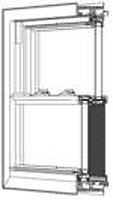 |
When replacing windows, look for double pane or triple pane windows. Just upgrading your single pane windows to double pane can improve the R-value, or insulating value by 200%. But, the greatest thermal improvement comes with the addition of low-emissivity coatings, insulating gases, and warm-edge technology. |
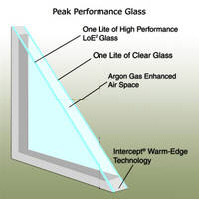 |
Low E Glass‘Green’ Glass Solutions |
 |
Air trapped between two or three panes of glass acts as an insulator. But for improved energy saving performance, the addition of Argon or Krypton gas to the air space provides greater insulating values. Argon and Krypton are non-toxic, odorless and colorless gases that create a thermal barrier between your home’s interior and the fluctuating conditions outside. Dual pane windows with Low-E glass and Argon gas provide four times the insulating value of single pane glass. For the ultimate in energy saving performance, triple pane glass with Low-E and Krypton gas provides nine times the insulating performance of inefficient single pane glass.
Also, look for windows that utilize warm-edge technology. Warm-edge spacer systems seal the insulating glass units and flex with the glass in hot or cold temperatures to help prevent seal failures. These insulating spacer systems also keep the edges of the glass warmer, dramatically reducing condensation while keep warm air in and cold air out.
Topic: Design Ideas with Vinyl Replacement Windows
Did you know that you can completely transform the look of your home just by choosing different window shapes and styles when replacing your current windows? You can choose from our assortment of V-Bow, Flanker, Oriel and Picture Windows. To brighten a dark room, you can add our Wall of Windows to give you that great outdoors feel! Our vinyl replacement window styles can offer your home a unique new look, or accommodate any special architectural requirements your home may have.
V-Bow WindowsA V-Bow is an exclusive vinyl replacement window design from Thermal Industries consisting of two casement windows extending from a wood surround. A V-Bow often used when a homeowner would like to have the light and space a bay or bow provides, but do not have the space in the window opening for these larger designs. |
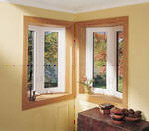 |
Picture WindowsPicture Windows have fixed sashes that do not open or close and may be used as the focal point in a room, or accent to other window styles. |
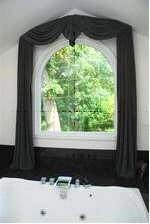 |
Flanker WindowsA window unit placed along side of another unit. A picture window may be flanked by a double hung on each side, or casements. |
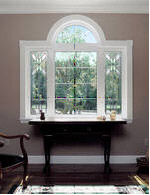 |
Wall of WindowsPicture windows, casements and awnings can be stacked or flanked to create a wall of windows that maximize light and your view. |
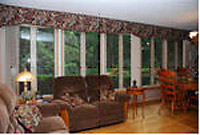 |
Oriel WindowsAn Oriel window is a double hung window that has a meeting rail located off center of the frame. Most oriel windows have a 60/40 configuration. |
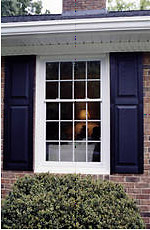 |
Topic: Cleaning and Care Tips for Vinyl Replacement Windows
How to Operate and Clean Your New Vinyl Replacement Windows
Download our Operating & Cleaning Manual.
How to Clean Insulating Glass and Hardware
Insulating Glass
Insulating glass can be cleaned with any non-abrasive glass cleaner and soft cloth.
Low Emissivity Glass
Our LoE2 insulating glass packages can be cleaned with any non-
abrasive glass cleaner and soft cloth. The LoE2 coating is applied to
the inner surface of the insulating glass unit and therefore, cannot be scratched.
DreamGlas®
Etched, jewel cut, and glass units with caming can be cleaned with any non-abrasive, mild cleaner and a soft cloth (without loose strings or edges that can catch/loosen the caming). Use of abrasive or caustic cleaners will void the warranty. Also, care must be taken not to use any type of scraping instrument on or around your camed glass unit, as it may delaminate.
The lead came option uses 100% lead came, which will form a protective oxidation when exposed to the environment. You should not attempt to remove this coating.
The brass came option uses a real brass cap over the came body, and can tarnish. It can be carefully polished with commercially available brass polishes such as Brasso®. Take care not to get excessive polish on the glass, and remove any polish on the glass.
Hardware
Window and door hardware can be cleaned with any non-abrasive, mild cleaner and soft cloth.
How to Clean and Maintain Vinyl Replacement Window and Patio Frames
Vinyl windows and doors come closer to being maintenance-free than most exterior building products. They may become dirty just as does a freshly painted house, a new automobile, or any other product that is exposed to atmospheric conditions. With very little effort, you can keep your vinyl window and door frames clean. In most cases, a heavy rain is sufficient to clean these products.
DO NOT wash windows with a high pressure spray. If rain does not do a satisfactory job, follow these simple instructions.
These instructions are based on a study conducted by the Vinyl Window and Door Institute on the efficiency of cleaning agents and their effects on the appearance of vinyl window frames after two years of outdoor exposure.
Normal Maintenance
Wash using a soft cloth or ordinary long-handled soft bristle brush.
For difficult-to-remove dirt and stains such as top soil, motor oil, lithium grease, crayon, felt-tip pen, caulking, lipstick, grass, bubble gum, mold and mildew, use the readily available household cleaners listed on the following page. Follow manufacturer’s instructions on use of cleaners.
In some cases, you may wish to use a mildly abrasive cleaner, such as Soft Scrub®, Ajax®, Bon Ami®, etc., but the use of any abrasive material could have a negative effect on the glass surface and window or door frames. DO NOT use any type of abrasive cleaners or Brillo Pads on DreamWood, Natural Wood Grain, or Honey/Caramel Oak Woodgrain Finishes.
Do not use cleaners containing aggressive organic solvents because they could affect the surface appearance of the vinyl. Examples of such cleaners are: chlorine bleach, liquid grease remover, strong soaps and detergents containing organic solvents, nail polish remover and furniture polish/cleaner.
For Natural Woodgrain Interior Laminate, and Honey/Caramel Laminate Woodgrain Finishes, use mild household cleaners from suggested list. DO NOT use harsh abrasive cleaners or Brillo Pads on these surfaces. Use a Mr. Clean® Magic Eraser® on the Honey/ Caramel Oak laminate surfaces for hard to clean areas. DO NOT use Magic Eraser® on Natural WoodGrain surfaces.
Suggested Cleaners in Alphabetical Order By Problem:
- BUBBLE GUM: Fantastik®, Murphy Oil Soap®, Windex®, Solution of vinegar (30%) and water (70%)
- CRAYON: Lestoil®
- DAP (Oil-based caulk): Fantastik®
- GRASS: Fantastik®, Lysol®, Murphy Oil Soap®, Windex®
- LIPSTICK: Fantastik®, Lysol®, Murphy Oil Soap®
- LITHIUM GREASE: Fantastik®, Lestoil®, Murphy Oil Soap®, Windex®
- Mr. Clean® Magic Eraser®
- MOLD & MILDEW: Fantastik®, Windex®, Solution of vinegar (30%) and water
- MOTOR OIL: Fantastik®, Lysol®, Murphy Oil Soap®, Windex®
- OIL: Soft Scrub®
- PAINT: Brillo Pad, Soft Scrub®
- PENCIL: Soft Scrub®
- RUST: Fantastik®, Murphy Oil Soap®, Windex®
- TAR: Soft Scrub®
- TOP SOIL: Fantastik®, Lestoil®, Murphy Oil Soap®
NOTE: VARCO does not endorse proprietary products or processes and makes no warranties for the products referenced herein. References to proprietary names is for illustrative purposes only and is not intended to imply that there are not equally effective alternatives.
Topic: Understanding Condensation
Indoor Condensation
The installation of your new windows has made your home more air-tight and energy efficient. Over the years, you will save considerable energy dollars and enjoy a more comfortable living environment as a result of your investment.
Now that your house is more air-tight, moisture created by everyday activities (cooking, bathing, laundry, etc.) is no longer escaping through the drafty holes and cracks of your old windows. This moisture, now trapped in your home, looks for a place to rest/collect. Most often this moisture or "condensation" collects on your windows. It is important to understand that windows do not cause condensation; they simply reflect a condition in the home. Condensation is an indication of too much moisture in the air which manifests itself on the glass surface in three ways; (1) fogging, (2) droplets, (3) ice.
A little condensation is quite normal, and moisture can add to the comfort of an extremely dry home. However, excessive condensation can cause damage to paint, wallpaper and plaster if not controlled. The good news is, condensation can be controlled by reducing the sources of humidity within your home to an acceptable level of comfort.
Outdoor Condensation
During the spring, summer and fall seasons, when warm days are followed by cool nights, moisture may collect on the outside pane of glass on your windows. This collection of droplets is called dew, and is the same type of condensation you may see on your car windshield or lawn in the morning.
Insulating glass units utilizing high-performance glass systems, such as Peak and Super Peak Performance™ Glass, are designed to reduce the amount of heat that flows from the inside of your home, to the outside of your home, during colder weather. By keeping more heat inside your home, the outside surface of the insulating glass unit stays colder. When the glass surface of your windows falls below the dew point (that's when water vapor in the air begins to condense), condensation forms on the outside glass surface.
Therefore, if you see condensation on the outside of your windows, this is visible evidence that your energy is being saved, and that your window investment is paying off.
Helpful Hints to Control Condensation*
- Shut off furnace humidifier and any other humidifying device in your home until condensation subsides.
- Be sure that louvers in the attic or basement crawl spaces are open and that they are large enough to allow adequate air flow.
- Run kitchen or other ventilating fans while cooking.
- Run exhaust fans while showering and keep bathroom door closed.
- Do not hang full loads of wet laundry inside your home to dry during the heating season.
- Vent clothes dryer to the outdoors.
- Open fireplace damper.
- Open a window and air out your house for a few minutes each day.
- If troublesome condensation persists, see your heating contractor about an outside air intake for your furnace.
*University of Minnesota Engineering Laboratory
NOTE: Condensation on glass is a natural result of excess moisture in the house and does not indicate a defective product or faulty installation. Maintaining proper household humidity levels may prevent problems such as mold, mildew and related health issues. In no event shall VARCO be liable for any damages including special, incidental or consequential damages resulting from condensation, mold or mildew. If you become aware of persistent condensation on your windows, you should take immediate remedial action to prevent water, mold and/or mildew damage to your property and to avoid potential health risks. Additional information is available upon request.
Topic: Window Safety
National Window Safety Week
The National Safety Council
(NSC) and top fenestration industry organizations have declared the first full week of April every year as National Window Safety Week, which is timed to coincide with spring the time of year when homeowners are again opening their windows.
This year, National Window Safety Week is April 1-7, 2012. Learn more by visiting the NSC Web site.
Additional resources:
- Information on the Window Safety Task Force
- Window safety checklist
(pdf, 434 KB)
Window Safety Checklist*
Fires and falls of all kinds are among the leading causes of injury and death in young children. While some falls occur from windows, it is important to realize that in the event of a fire, a window can also save a child's life. This is why windows play a critical role in home safety. Print out this checklist from the National Safety Council and use these tips to help keep your family safe around the windows and patio doors in your home.
Has your family developed an emergency fire escape plan?
Determine your family's emergency escape plan and practice it regularly. In the plan, include two avenues of escape from every room. Remember, children may have to rely on a window to escape a fire. Help them learn to safely use a window under these circumstances. Make sure you have identified a safe meeting place outside.
Do you keep windows shut when children are around?
You should keep your windows closed and locked when children are around. When opening windows for ventilation, open windows that children cannot reach. Also, set and enforce rules about keeping children's play away from windows and/or patio doors. Falling through the glass can be fatal or cause a serious injury.
Do you leave, or have you left, windows open because you thought the insect screen provided a safeguard from a fall?
Don't rely on insect screens to prevent a fall. Insect screens are designed to provide ventilation while keeping insects out; they are not designed to, nor will they prevent a child's fall from a window.
Is there furniture placed under or near windows in your home?
Keep furniture, or anything children can climb, away from windows. Children may use such objects as a climbing aid.
Do you have any window unit air conditioners in bedroom windows or other windows in your home that may be needed for escape or rescue in an emergency?
Do not install window unit air conditioners in windows that may be needed for escape or rescue in an emergency. The air conditioning unit could block or impede escape through the window. Always be sure that you have at least one window in each sleeping and living area that meets escape and rescue requirements.
High Rise Fire Safety**
The United States Fire Administration (USFA) would like you to know there are simple fire safety steps you can take to prevent the loss of life and property in high-rise fires.
Danger Above: A Fact Sheet on High-Rise Safety
Recent fatal fires in high-rise structures have prompted American to rethink fire safety. A key to fire safety for those who live and work in these special structures is to practice specific high-rise fire safety and prevention behaviors.
Never Lock fire exits or doorways, halls or stairways. Fire doors provide a way out during the fire and slow the spread of fire and smoke. Never prop stairway or other fire doors open.
Learn your building evacuation plan. Make sure everyone knows what to do if the fire alarm sounds. Plan and practice your escape plan together.
Be sure your building manager posts evacuation plans in high traffic areas, such as lobbies.
Learn the sound of your building's fire alarm and post emergency numbers near all telephones.
Know who is responsible for maintaining the fire safety systems. Make sure nothing blocks these devices and promptly report any sign of damage or malfunction to the building management.
Do Not Panic in the Event of a High-Rise Fire Emergency.
Do not assume anyone else has already called the fire department.Immediately call your local emergency number. Early notification of the fire department is important. The dispatcher will ask questions regarding the emergency. Stay calm and give the dispatcher the information they request.
If the Door is Warm to the Touch<
Before you try to leave your apartment or office, feel the door with the back of your hand. If the door feels warm to the touch, do not attempt to open it. Stay in your apartment of office.
Stuff the cracks around the door with towels, rags, bedding or tape and cover vents to keep smoke out.
If there is a phone in the room where you are trapped, call the fire department again to tell them exactly where you are located. Do this even if you can see fire apparatus on the street below.
Wait at a window and signal for help with a flashlight or by waving a sheet.
If possible, open the window at the top and bottom, but do not break it, you may need to close the window if smoke rushes in.
Be patient. Rescuing all the occupants of a high-rise buidling can take several hours.
If the Door is Not Warm to the Touch
If you do attempt to open the door, brace your body against the door while staying low to the floor and slowly open it a crack. What you are doing is checking for the presence of smoke or fire in the hallway.
If there is no smoke in the hallway or stairwells, follow your building's evacuation plan.
If you don't hear the building's fire alarm, pull the nearest fire alarm "pull station" while exiting the floor.
If you encounter smoke or flames on your way out, immediately return to your apartment or office.
After a High-Rise Fire Emergency
Once you are out of the building, STAY OUT! Do not go back inside for any reason.
Tell the fire department if you know of anyone trapped in the building.
Only enter when the fire department tells you it is safe to do so.
Maintain and Install Working Smoke Alarms
No matter where you live, always install smoke alarms on every level of you home. Test them monthly and change the batteries at least once a year. Remember, fire safety is your personal responsibility...Fire Stops With You!
*Reprinted from the National Safety Council. For additional information, visit http://www.nsc.org/
**Reprinted from the United States Fire Administration. For additional information visit: http://www.usfa.dhs.gov/
![]() ©2012-2020 VARCO Windows & Doors Inc.
©2012-2020 VARCO Windows & Doors Inc.
